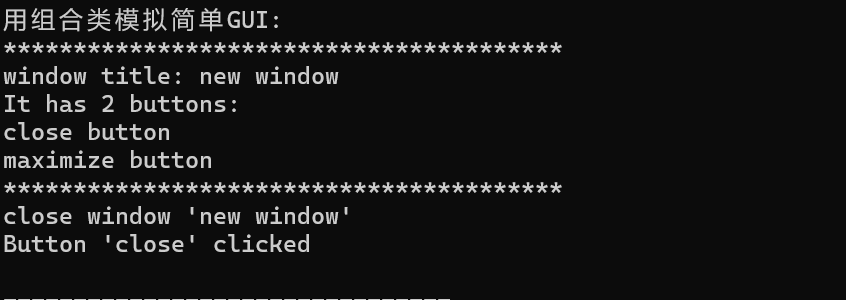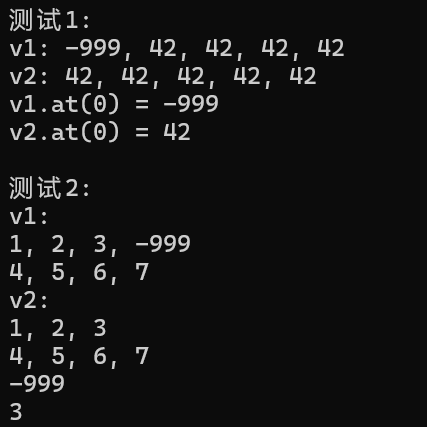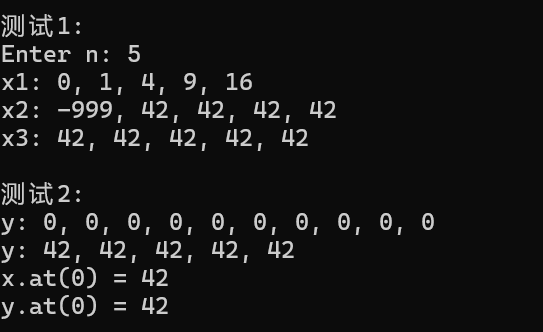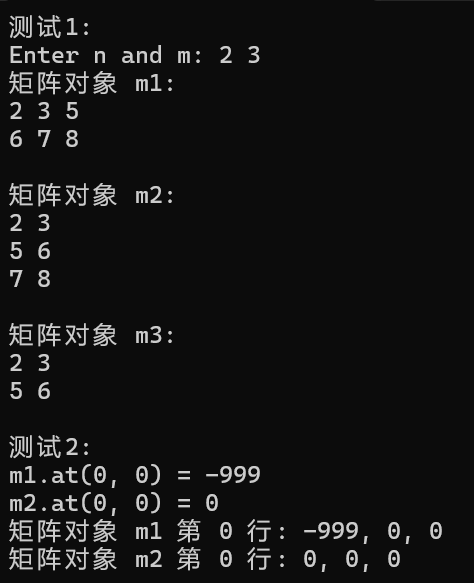c++程序设计基础实验三
任务1:
源代码:
button.hpp:
#pragma once
#include <iostream>
#include <string>
using std::string;
using std::cout;
// 按钮类
class Button {
public:
Button(const string &text);
string get_label() const;
void click();
private:
string label;
};
//自定义Button类
Button::Button(const string &text): label{text} {}
inline string Button::get_label() const {
return label;//内联函数,返回label名字
}
void Button::click() {
cout << "Button '" << label << "' clicked\n";
}
window.hpp:
#pragma once
#include "button.hpp"
#include <vector>
//把每一个字符串元素的Button装到vector容器里面
#include <iostream>
using std::vector;
using std::cout;
using std::endl;
// 窗口类
class Window{
public:
Window(const string &win_title);
void display() const;
void close();
void add_button(const string &label);
private:
string title;
vector<Button> buttons;
};
//自定义窗口类
Window::Window(const string &win_title): title{win_title} {
buttons.push_back(Button("close"));//不需要设置为内联函数,因为调用次数少,不需要提前编译
}
inline void Window::display() const {
string s(40, '*');
cout << s << endl;
cout << "window title: " << title << endl;
cout << "It has " << buttons.size() << " buttons: " << endl;
for(const auto &i: buttons)
cout << i.get_label() << " button" << endl;
cout << s << endl;
}
void Window::close() {
cout << "close window '" << title << "'" << endl;
buttons.at(0).click();
}
void Window::add_button(const string &label) {
buttons.push_back(Button(label));
}
task1.cpp:
#include "window.hpp" #include <iostream> using std::cout; using std::cin; void test() { Window w1("new window"); w1.add_button("maximize"); w1.display(); w1.close(); } int main() { cout << "用组合类模拟简单GUI:\n"; test(); }
运行结果截图:

问题1:
在该项目中,自定义了Button类和Window类;用到了标注库中的string类和vector类;Button类和string类存在组合关系,Window类和vector类存在组合关系。
问题2:
Button类中的click函数不需要设置为inline内联函数,因为在后续的Window类中它的调用次数比较少;
Window类中的close函数也是这样,它的调用只存在于要结束运行时且只需要调用一次;
Window类中的add函数可以设置为内联函数,在大规模加入新的Window窗口时,将它设置为内联函数可以减少运行时间。
问题3:
这一行的代码作用是输出四十个‘*’字符在每次调用Window类中的函数的第一行,主要是为了将每次的调用人为地分隔开,使得运行界面更加简洁明了。
任务2:
源代码:
task2.cpp:
#include <iostream> #include <vector> using namespace std; void output1(const vector<int> &v) { for(auto &i: v) cout << i << ", "; cout << "\b\b \n"; } void output2(const vector<vector<int>> v) { for(auto &i: v) { for(auto &j: i) cout << j << ", "; cout << "\b\b \n"; } } void test1() { vector<int> v1(5, 42); const vector<int> v2(v1); v1.at(0) = -999; cout << "v1: "; output1(v1); cout << "v2: "; output1(v2); cout << "v1.at(0) = " << v1.at(0) << endl; cout << "v2.at(0) = " << v2.at(0) << endl; } void test2() { vector<vector<int>> v1{{1, 2, 3}, {4, 5, 6, 7}}; const vector<vector<int>> v2(v1); v1.at(0).push_back(-999); cout << "v1: \n"; output2(v1); cout << "v2: \n"; output2(v2); vector<int> t1 = v1.at(0); cout << t1.at(t1.size()-1) << endl; const vector<int> t2 = v2.at(0); cout << t2.at(t2.size()-1) << endl; } int main() { cout << "测试1:\n"; test1(); cout << "\n测试2:\n"; test2(); }
运行结果截图:

回答问题:
问题1:
这三行代码的功能是将v1初始化为五个42的vector容器,并将v2初始化为v1,然后将v1中的第一个元素变为-999.
问题2:
这三行代码的功能是将v1初始化为两个元素的vector类,一个元素为{1,2,3},一个元素为{4,5,6,7};并将不能改变的const类v2初始化为v1,然后在v1第一个元素的后面加上-999。
问题3:
将vector类t1,t2分别用v1,v2的第一个元素初始化,其中t2和v2一样都是无法改变值的cosnt类,然后输出t1,t2的最后一个元素。
问题4:
标准库模板类vector内部封装的复制构造函数,其实现机制是深复制。创建的新vector对象和原来的vector对象互相不干涉,新对象有自己独立的内存空间。
是的,vector类中的at()函数至少要有一个const类的函数接口来确保能对const类型的数据进行引用。
任务3:
源代码:
vectorInt.hpp:
#pragma once #include <iostream> #include <cassert>//储存assert宏的关键字 using std::cout; using std::endl; // 动态int数组对象类 class vectorInt{ public: vectorInt(int n); vectorInt(int n, int value); vectorInt(const vectorInt &vi); ~vectorInt(); int& at(int index); const int& at(int index) const; vectorInt& assign(const vectorInt &v); int get_size() const; private: int size; int *ptr; // ptr指向包含size个int的数组 }; vectorInt::vectorInt(int n): size{n}, ptr{new int[size]} { } vectorInt::vectorInt(int n, int value): size{n}, ptr{new int[size]} { for(auto i = 0; i < size; ++i) ptr[i] = value; } vectorInt::vectorInt(const vectorInt &vi): size{vi.size}, ptr{new int[size]} { for(auto i = 0; i < size; ++i) ptr[i] = vi.ptr[i]; } vectorInt::~vectorInt() { delete [] ptr; } const int& vectorInt::at(int index) const { assert(index >= 0 && index < size);//assert关键字,可以检查是否符合括号里面的条件 return ptr[index]; } int& vectorInt::at(int index) { assert(index >= 0 && index < size); return ptr[index]; } vectorInt& vectorInt::assign(const vectorInt &v) {//容器中的assign函数,可以实现复制的作用 delete[] ptr; // 释放对象中ptr原来指向的资源 size = v.size; ptr = new int[size]; for(int i = 0; i < size; ++i) ptr[i] = v.ptr[i]; return *this; } int vectorInt::get_size() const { return size; }
task3.cpp:
#include "vectorInt.hpp" #include <iostream> using std::cin; using std::cout; void output(const vectorInt &vi) { for(auto i = 0; i < vi.get_size(); ++i) cout << vi.at(i) << ", "; cout << "\b\b \n"; } void test1() { int n; cout << "Enter n: "; cin >> n; vectorInt x1(n); for(auto i = 0; i < n; ++i)x1.at(i) = i*i; cout << "x1: "; output(x1); vectorInt x2(n, 42); vectorInt x3(x2); x2.at(0) = -999; cout << "x2: "; output(x2); cout << "x3: "; output(x3); } void test2() { const vectorInt x(5, 42); vectorInt y(10, 0); cout << "y: "; output(y); y.assign(x); cout << "y: "; output(y); cout << "x.at(0) = " << x.at(0) << endl; cout << "y.at(0) = " << y.at(0) << endl; } int main() { cout << "测试1: \n"; test1(); cout << "\n测试2: \n"; test2(); }
运行结果截图:

问题1:
该拷贝构造函数是浅复制,因为只定义了一套新的指针指向要复制的对象,并没有开辟新的内存空间储存复制对象。
问题2:
不能够正常运行,因为去掉&引用符号后,代码将不能修改要引用的数据的值,而在测试代码中有修改数据的操作,故不能正常运行。
有安全隐患,将该函数的const前缀去掉之后,编译后再运行编译器可能无法保护本应该被保护的数据,导致const变量被修改;同时const函数也无法返回非const变量,即使它是被引用的。
问题3:
不可以,返回值为&vectorInt类型使得assign函数可以直接去改变要改变的值;去掉&后,编译器会创建要改变的vectorInt类的副本,会浪费系统的内存和编译时间,也不会改变原来的vectorInt对象。
观察和思考:
标准库中的vector动态数组可以实现数据的动态储存,不需要声明容量,而自己定义的vectorInt类则需要提前声明容量n,否则无法使用;
标准库中的vector动态数组通过内存预处理来实现动态容纳数据,而自己设计的vectorInt中通过指针来管理,指针的安全性较低,可能会造成内存泄漏;
标准库中的vector动态数组定义了许多功能强大的功能函数,方便处理数据,而自己的vectorInt类含有较少的函数;
标准库中的vector动态数组经过优化,有较高的性能和效率,可以大规模处理数据,而自己的vectorInt类在处理大规模数据时可能会导致内存,编译时间等方面的问题。
任务4:
源代码:
matrix.hpp:
#pragma once #include <iostream> #include <cassert> using std::cout; using std::endl; class Matrix { public: // 构造函数,创建一个 n * m 的矩阵,初始化为 0 Matrix(int n, int m) : lines(n), cols(m) { assert(n > 0 && m > 0); ptr = new double[lines * cols](); // 分配内存并初始化为 0 } // 构造函数,创建一个 n * n 的矩阵,初始化为 0 Matrix(int n) : lines(n), cols(n) { assert(n > 0); ptr = new double[lines * cols](); // 分配内存并初始化为 0 } // 复制构造函数,使用已有矩阵 x 的数据构造新矩阵 Matrix(const Matrix &x) : lines(x.lines), cols(x.cols) { ptr = new double[lines * cols]; for (int i = 0; i < lines * cols; ++i) { ptr[i] = x.ptr[i]; // 按元素复制 } } // 析构函数,释放内存 ~Matrix() { delete[] ptr; } // 用 pvalue 指向的内存块数据按行赋值 void set(const double *pvalue) { for (int i = 0; i < lines * cols; ++i) { ptr[i] = pvalue[i]; } } // 清空矩阵,将所有元素置为 0 void clear() { for (int i = 0; i < lines * cols; ++i) { ptr[i] = 0.0; } } // 返回矩阵元素(i, j)的常量引用 const double& at(int i, int j) const { assert(i >= 0 && i < lines && j >= 0 && j < cols); // 确保索引合法 return ptr[i * cols + j]; } // 返回矩阵元素(i, j)的引用 double& at(int i, int j) { assert(i >= 0 && i < lines && j >= 0 && j < cols); // 确保索引合法 return ptr[i * cols + j]; } // 返回矩阵的行数 int get_lines() const { return lines; } // 返回矩阵的列数 int get_cols() const { return cols; } // 显示矩阵的元素值 void display() const { for (int i = 0; i < lines; ++i) { for (int j = 0; j < cols; ++j) { cout << at(i, j) << " "; } cout << endl; } } private: int lines; // 矩阵的行数 int cols; // 矩阵的列数 double *ptr; // 矩阵元素的指针 };
task4.cpp:
#include "matrix.hpp" #include <iostream> #include <cassert> using std::cin; using std::cout; using std::endl; const int N = 1000; // 输出矩阵对象索引为 index 所在行的所有元素 void output(const Matrix &m, int index) { assert(index >= 0 && index < m.get_lines()); for (int j = 0; j < m.get_cols(); ++j) cout << m.at(index, j) << ", "; cout << "\b\b \n"; } void test1() { double x[1000] = {2,3,5,6,7,8,9,1,4}; int n, m; cout << "Enter n and m: "; cin >> n >> m; Matrix m1(n, m); // 创建矩阵对象 m1, 大小 n×m m1.set(x); // 用一维数组 x 的值按行为矩阵 m1 赋值 Matrix m2(m, n); // 创建矩阵对象 m2, 大小 m×n m2.set(x); // 用一维数组 x 的值按行为矩阵 m2 赋值 Matrix m3(2); // 创建一个 2×2 矩阵对象 m3.set(x); // 用一维数组 x 的值按行为矩阵 m3 赋值 cout << "矩阵对象 m1: \n"; m1.display(); cout << endl; cout << "矩阵对象 m2: \n"; m2.display(); cout << endl; cout << "矩阵对象 m3: \n"; m3.display(); cout << endl; } void test2() { Matrix m1(2, 3); m1.clear(); // 清空矩阵 m1 const Matrix m2(m1); // 通过 m1 创建矩阵 m2 m1.at(0, 0) = -999; // 修改 m1 的第 (0, 0) 元素 cout << "m1.at(0, 0) = " << m1.at(0, 0) << endl; cout << "m2.at(0, 0) = " << m2.at(0, 0) << endl; // 输出 m2 对应元素 cout << "矩阵对象 m1 第 0 行: "; output(m1, 0); cout << "矩阵对象 m2 第 0 行: "; output(m2, 0); } int main() { cout << "测试1: \n"; test1(); cout << "测试2: \n"; test2(); return 0; }
运行结果截图:

任务5:
源代码:
user.hpp:
#pragma once #include <iostream> #include <string> #include <vector> #include <cassert> using std::string; using std::cin; using std::cout; using std::endl; class User { private: string name; // 用户名 string password; // 密码 string email; // 邮箱 public: // 构造函数1:仅通过用户名构造,默认密码为 "123456",邮箱为空 User(const string& user_name) : name(user_name), password("123456"), email("") {} // 构造函数2:通过用户名、密码和邮箱构造 User(const string& user_name, const string& user_password, const string& user_email) : name(user_name), password(user_password), email(user_email) {} // 设置邮箱 void set_email() { cout << "Enter email address: "; cin >> email; while (email.find('@') == string::npos) { cout << "illegal email.please re-enter email: "; cin >> email; } cout<<"email is set suvvessfully..."<<endl; } // 修改密码 void change_password() { string old_password; string new_password; int attempts = 0; // 循环要求用户输入旧密码,最多尝试三次 while (attempts < 3) { cout << "Enter old password: "; cin >> old_password; // 检查密码是否正确 if (old_password == password) { cout << "Enter new password: "; cin >> new_password; password = new_password; // 修改密码 cout << "new password is set successfully!" << endl; return; } else { cout << "Password input error,please re-enter again。" << endl; attempts++; } } // 如果三次输入错误,则提示用户稍后再试 if (attempts == 3) { cout << "Password input error,please try after a while" << endl; } } // 显示用户信息,密码以 * 显示 void display() const { cout << "name: " << name << endl; cout << "pass: "; for (size_t i = 0; i < password.size(); ++i) { cout << "*"; // 用 * 代替密码显示 } cout << endl; cout << "email: " << email << endl; } };
task5.cpp:
#include "user.hpp" #include <iostream> #include <vector> #include <string> using std::cin; using std::cout; using std::endl; using std::vector; using std::string; void test() { vector<User> user_lst; User u1("Alice", "2024113", "Alice@hotmail.com"); user_lst.push_back(u1); cout << endl; User u2("Bob"); u2.set_email(); u2.change_password(); user_lst.push_back(u2); cout << endl; User u3("Hellen"); u3.set_email(); u3.change_password(); user_lst.push_back(u3); cout << endl; cout << "There are " << user_lst.size() << " users. they are: " << endl; for(auto &i: user_lst) { i.display(); cout << endl; } } int main() { test(); }
运行结果截图:

任务6:
源代码:
//account.h #ifndef __ACCOUNT_H__ #define __ACCOUNT_H__ #include "date.h" #include <string> class SavingsAccount {//储蓄账户类 private: std::string id;//账号 double balance;//余额 double rate;//存款的年利率 Date lastDate;//上次变更余额的时期 double accumulation;//按日累加以和 static double total;//所有账户的总金额 //记录一笔账,date为日期,amount为金额,desc为说明 void record(const Date & date, double amount, const std::string & desc); //报告错误信息 void error(const std::string & msg) const; //获得指定日期为止的存款金额按日累增值 double accumulate(const Date & date) const { return accumulation + balance * date.distance(lastDate); } public: //构造函数 SavingsAccount(const Date & date, const std::string & id, double rate);//获得账号 const std::string & getId() const { return id; } //获得余额 double getBalance() const { return balance; } //获得年利率 double getRate() const { return rate; } static double getTotal() { return total; }//存入现金 void deposit(const Date & date, double amount, const std::string & desc);//取出现金 void withdraw(const Date & date, double amount, const std::string & desc);//结算利息,每年1月1日调用一次该函数 void settle(const Date & date); //显示账户信息 void show() const; }; #endif //__ACCOUNT_H__#pragma once //date.h #ifndef __DATE_H__ #define __DATE_H__ class Date {//日期类 private: int year; //年 int month;//月 int day;//日 int totalDays;//该日期是从公元元年1月1日开始的第几天 public: Date(int year, int month, int day);//用年、月、日构造日期 int getYear() const { return year; } int getMonth() const { return month; } int getDay() const { return day; } int getMaxDay() const;//获得当月有多少天 bool isLeapYear() const {//判断当年是否为闰年 return year % 4 == 0 && year % 100 != 0 || year % 400 == 0; } void show() const;//输出当前日期 int distance(const Date & date) const { return totalDays - date.totalDays; } }; #endif //__DATE_H__ //account.cpp #include "account.h" #include <cmath> #include <iostream> using namespace std; double SavingsAccount::total = 0; //SavingsAccount类相关成员函数的实现 SavingsAccount::SavingsAccount(const Date &date,const string &id,double rate):id(id),balance(0),rate(rate),lastDate(date),accumulation(0){ date.show(); cout << "\t#" << id << " created" << endl; } void SavingsAccount::record(const Date & date, double amount, const string & desc) { accumulation = accumulate(date); lastDate = date; amount = floor(amount * 100 + 0.5) / 100; //保留小数点后两位 balance += amount; total += amount; date.show(); cout << "\t#" << id << "\t" << amount << "\t" << balance << "\t" << desc << endl; } void SavingsAccount::error(const string & msg) const { cout << "Error(#" << id << "): " << msg << endl; } void SavingsAccount::deposit(const Date & date, double amount, const string & desc) { record(date, amount, desc); } void SavingsAccount::withdraw(const Date & date, double amount, const string & desc) { if (amount > getBalance()) error("not enough money"); else record(date, -amount, desc); } void SavingsAccount::settle(const Date & date) { double interest = accumulate(date) * rate / date.distance(Date(date.getYear() - 1, 1, 1)); if (interest != 0) record(date, interest, "interest"); accumulation = 0; } void SavingsAccount::show() const { cout << "ID: " << id << "\tBalance: " << balance; } //date.cpp #include "date.h" #include <iostream> #include <cstdlib> using namespace std; namespace { //namespace使下面的定义只在当前文件中有效 const int DAYS_BEFORE_MONTH[] = { 0, 31, 59, 90, 120, 151, 181, 212, 243, 273, 304, 334, 356 }; } Date::Date(int year, int month, int day) :year(year), month(month), day(day) { if (day <= 0 || day > getMaxDay()) { cout << "Invalid date: "; show(); cout << endl; exit(1); } int years = year - 1; totalDays = years * 365 + years / 4 - years / 100 + years / 400 + DAYS_BEFORE_MONTH[month - 1] + day; if (isLeapYear() && month > 2) totalDays++; } int Date::getMaxDay() const { if (isLeapYear() && month == 2) return 29; else return DAYS_BEFORE_MONTH[month] - DAYS_BEFORE_MONTH[month - 1]; } void Date::show() const { cout << getYear() << "-" << getMonth() << "-" << getDay(); } //6.25.cpp #include "account.h" #include <iostream> using namespace std; int main() { Date date(2008, 11, 1); //起始日期 //建立几个账户 SavingsAccount accounts[] = { SavingsAccount(date, "03755217", 0.015), SavingsAccount(date, "02342342", 0.015) }; //几笔账目 accounts[0].deposit(Date(2008, 11, 5), 5000, "salary"); accounts[1].deposit(Date(2008, 11, 25), 10000, "sell stock 0323"); accounts[0].deposit(Date(2008, 12, 5), 5500, "salary"); accounts[1].withdraw(Date(2008, 12, 20), 4000, "buy a laptop"); //结算所有账户并输出各个账户信息 cout << endl; for (int i = 0; i < sizeof(accounts) / sizeof(SavingsAccount); i++) { accounts[i].settle(Date(2009, 1, 1)); accounts[i].show(); cout << endl; } cout << "Total: " << SavingsAccount::getTotal() << endl; return 0; }



